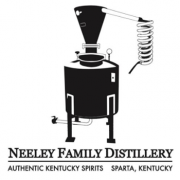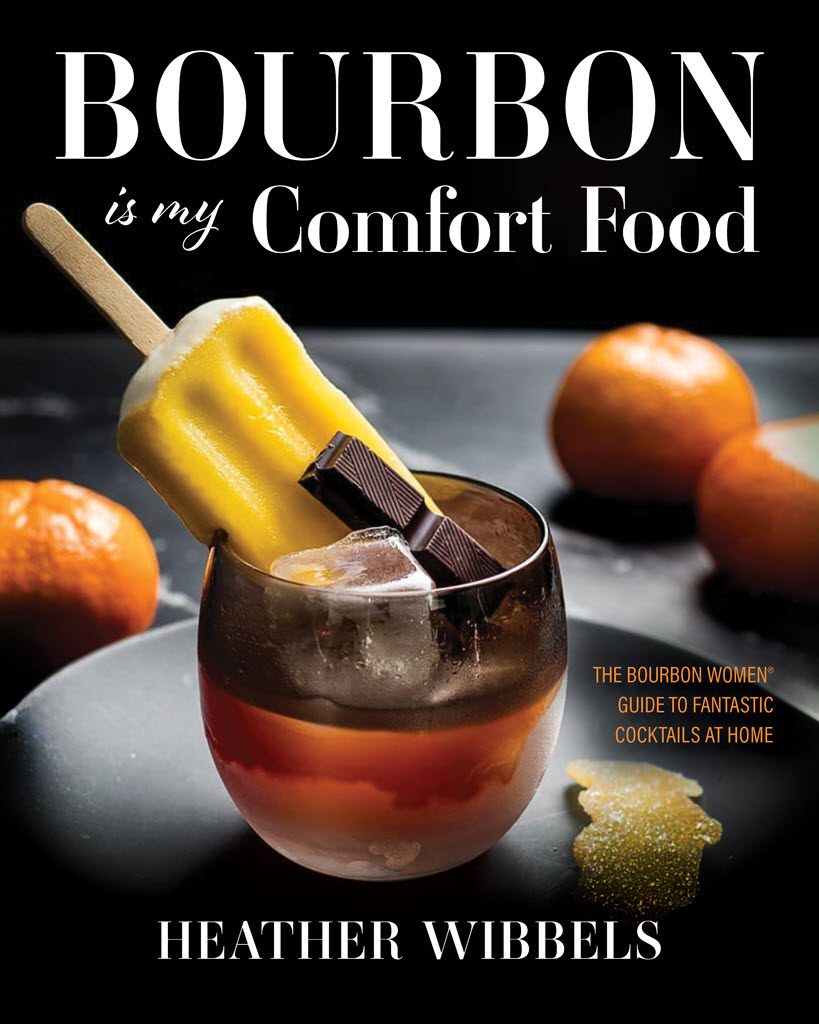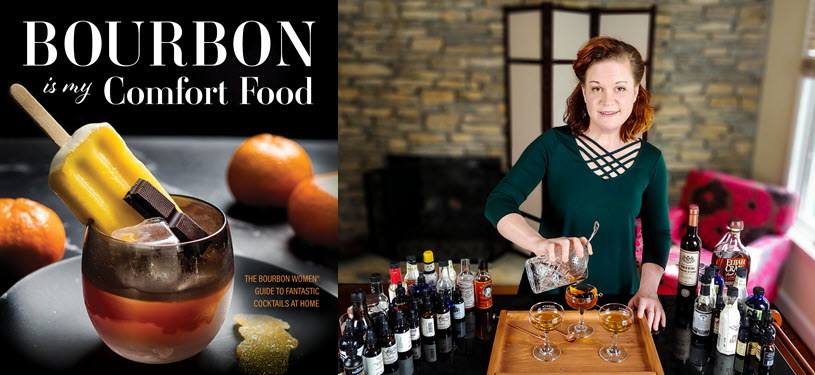
“Cocktails are the gateway to bourbon. Many bourbon enthusiasts start their journey with a bourbon cocktail. Handing a bourbon newbie a delectable, balanced, and beautifully presented cocktail makes bourbon approachable. It opens the door to explore what all the fuss (and fun) is about. It’s a springboard for the excitement of gathering with a group of friends to chat with whiskey in hand.”
We could not have said it better ourselves. Those are the words that come from Heather Wibbels, AKA Cocktail Contessa, on her nearly decade long journey from bourbon newbie to cocktail empress. Wibbels is Managing Director of the Bourbon Women Association, a columnist in a few whiskey and food magazines and now author. Her new book, “Bourbon is My Comfort Food: The Bourbon Women™ Guide to Fantastic Cocktails at Home”, is a beautiful book that every bourbon lover can turn to again and again on their bookshelf to make a variety of bourbon forward cocktails.
The book with more than 140 recipes is a primer not just on making great cocktails but it takes the reader on a journey of how to manipulate flavors on their own to create perfectly balanced cocktails to meet one’s own palate.
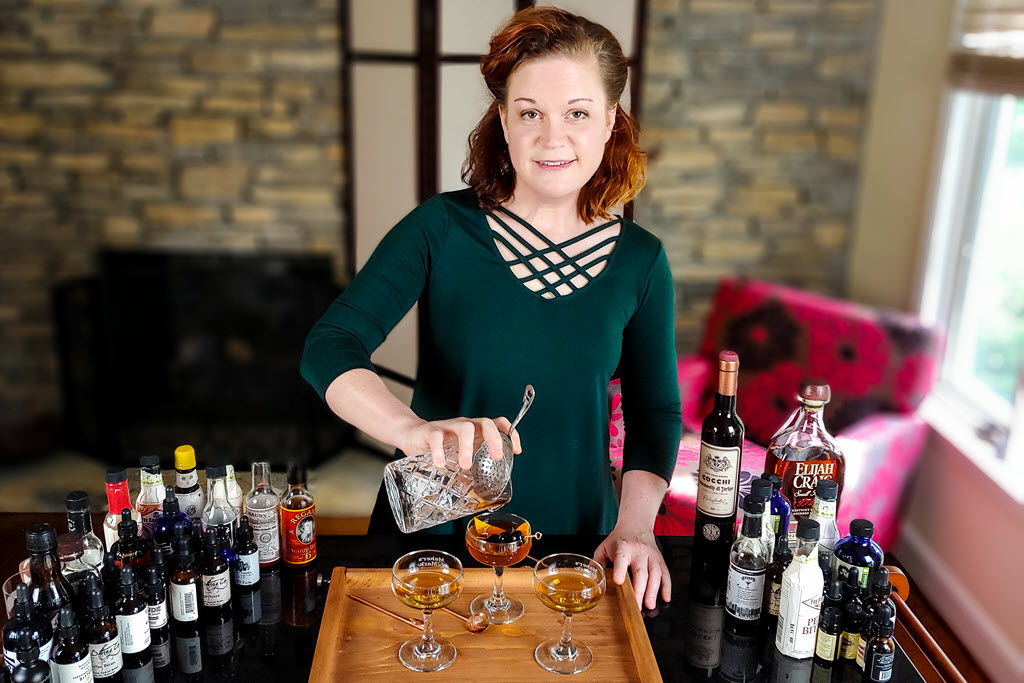
Stay Informed: Sign up here for the Distillery Trail free email newsletter and be the first to get all the latest news, trends, job listings and events in your inbox.
The books pages take you on a bourbon journey from bar basics, to how to stock your bar, to infusions and on to 100+ recipes with detailed tips, garnishes and beautiful photography.
To give you a taste of Bourbon is My Comfort Food we’re sharing a sample chapter on how to make the perfect Manhattan. You’ll soon discover, there is no single perfect Manhattan, there’s just the Manhattan that you feel like making in the moment. The book includes spirits history, recommended spirits and useful tips.
For example, did you know that unlike bourbon, that doesn’t really have a set shelf life, vermouth should be consumed within a few weeks of opening and that it should be refrigerated? Wibbels added, “If you compare a four-week-old, opened [bottle of] vermouth against a fresh bottle, you’ll be able to taste the difference.” And that difference will most definitely show through in your cocktail.
And without further ado, let’s jump right in to help you create your own delicious Manhattan or three!
The Manhattan
A Cocktail Classic for the Bourbon Drinker
When not sipping their bourbon neat, members of Bourbon Women often enjoy Manhattans. A spirit-forward drink that packs a tasty whiskey punch, a well-made Manhattan can be a symphony of bourbon, vermouth, and bitters that turns the cheeks pink and releases some of the best stories from the vault. Bourbon is the star of the show. Maybe that’s why early whiskey drinkers enjoyed the cocktail so much. It celebrates the elements that go into it instead of hiding bad whiskey behind other flavors.
History of the Manhattan
Like most classic cocktails, the Manhattan has an origin myth that’s more interesting than the much murkier truth. Legend has it that the Manhattan was first served at a party hosted by Winston Churchill’s mother in honor of a presidential candidate at the Manhattan Club in New York City. The party was so successful that people simply referred to the cocktail by the name of the club. Unfortunately, Mrs. Churchill was giving birth in Oxfordshire on the date of the party, so that story is now regarded as a myth.
WHISKEY TRIVIA
The earliest versions of the Manhattan cocktail didn’t use the now common 2:1 ratio of whiskey to vermouth. Early bartenders used equal amounts of both, with the addition of a healthy dose of bitters for balance. Today the ratio varies a bit—2–2½ ounces of whiskey to ½–1 ounce of sweet vermouth—but there’s no doubt bitters should be added, along with a citrus peel or cherry for garnish.
What we do know is that the cocktail was born at the Manhattan Club in New York in the 1880s, although we’re not sure who created it. At the time, vermouth, a fortified wine popular in Europe, had made its way to the United States and was being sold across the country. Given Americans’ proclivity for mixing up cocktails, it was inevitable that whiskey and vermouth would be combined.
Many whiskey drinkers now turn to bourbon for their Manhattans, but the earliest Manhattans were likely made with rye whiskey. Its pepper, spice, and creamy mouthfeel can cut through the sweet vermouth a little better than bourbon can. Today, both bourbon and rye are used to make the classic Manhattan, and the preferred spirit is often a matter of contention among cocktail enthusiasts. But you can decide for yourself.
The Three Elements of a Manhattan
The classic Manhattan has only three ingredients: whiskey, vermouth, and bitters. It’s not a complicated cocktail, but those three elements open the door to thousands of variations.
PROFESSIONAL TIP
Vermouth (both sweet and dry) should be refrigerated after opening, and it is best consumed within a few weeks. Because vermouth is a fortified wine and low in proof, its flavor changes as soon as it is opened. If you compare a four-week-old opened vermouth against a fresh bottle, you’ll be able to taste the difference.
Whiskey. The Manhattan was made for whiskey, and this is not a cocktail for bottom-shelf spirits. Use a bourbon or rye you love to drink neat or on the rocks. Choose a midproof bourbon for Manhattans or one with fullness, such as Michter’s, Woodford Double Oaked, New Riff, or Wilderness Trail. If you choose rye, the Manhattan will be spicy and peppery, and it will stand up to the sweetness of the vermouth.
Vermouth. Vermouth is a fortified wine infused with a proprietary blend of botanicals. Both the base wine and the botanicals drive the varied flavors of vermouths, and the recipes are highly guarded secrets. Manhattans use sweet or red vermouth (sometimes called Italian vermouth), but vermouth also comes in a dry style that is less sweet and paler in color. A third style, blanco or white, has a sweetness level between sweet and dry vermouth
Vermouth adds sweetness, herbal and floral notes, and slight sourness to a Manhattan. My two favorite sweet vermouths for Manhattans are Carpano Antica Formula vermouth (strong vanilla, orange, date, and chocolate flavors) and Cocchi Vermouth di Torino (cocoa, bitter orange, woody, and herbal notes). Both are very sweet, vibrant vermouths, and they pull out different aromas and flavors from different whiskeys. For a less sweet vermouth, try Dolin Rouge (citrus, dried fruit, herbaceous, and bitter notes).
Bitters. Traditionally, bartenders use Angostura bitters in a Manhattan, but there are hundreds of bitters to choose from. The bitters I use in my Manhattans depend on the specific whiskey. When mixing with Johnny Drum, I add Woodford Reserve sorghum and sassafras bitters to highlight the whiskey’s cinnamon notes. If I use Woodford Reserve Double Oaked, which is full of earthy aromas, I lighten the cocktail with orange or spiced cherry bitters. To create a flavor contrast, use bitters that differ from but are complementary to the spirits in the cocktail. For example, add chocolate bitters if you get caramel notes from the whiskey, or add nut bitters when you detect banana or apple.
Creating a Manhattan isn’t difficult, but it’s critical to use quality whiskeys and vermouths to make each element burst with flavor. Once you’ve mastered the basic Manhattan, experiment by adding different liqueurs or amari to build more layers of flavor into the cocktail. Remember, a Manhattan is always stirred, never shaken.
Classic Manhattan Cocktail
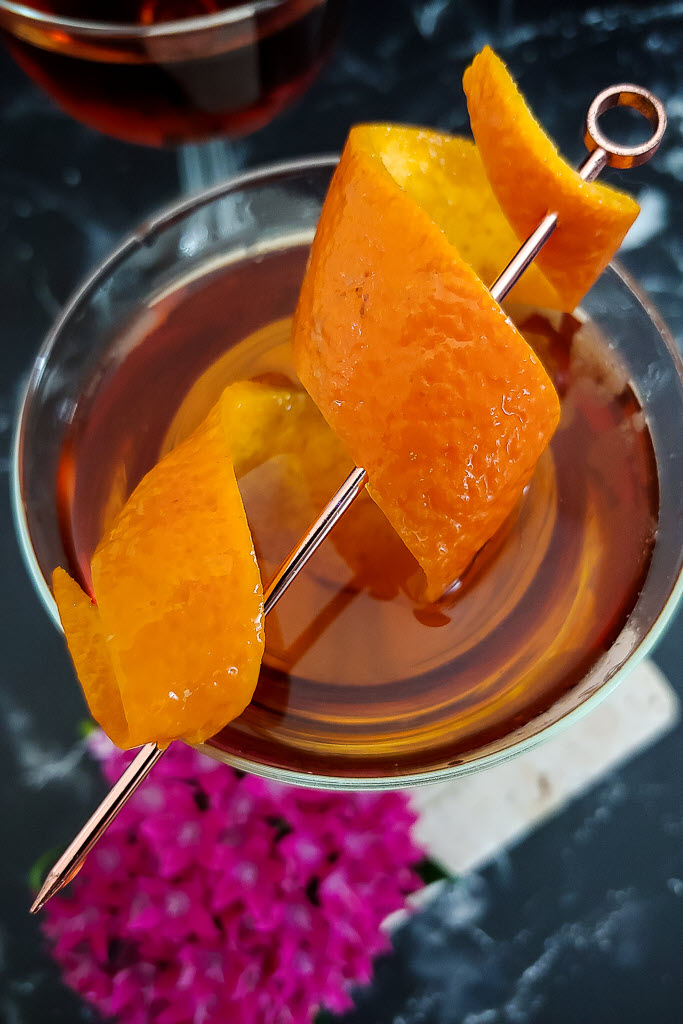
2 ounces bourbon
1 ounce high-quality sweet vermouth
2 dashes Angostura bitters
1 dash cherry bitters
Garnish: high-quality cocktail cherry
Add ingredients to a mixing glass. Fill with ice and stir for 30 seconds. Strain into a chilled coupe glass and garnish.
Making Your Own Riff on the Manhattan
The classic Manhattan is a bar staple, but the simplicity of the elements opens up the possibilities for many delicious variations. Some become standards in their own right, such as the Black Manhattan and the Perfect Manhattan. Others are simply fun riffs on the basic flavors and contrasts. Experimenting with each flavor element in the Manhattan allows you to use your imagination to build new variations.
VERMOUTH-OF-THE-MONTH CLUB
If you know a group of Manhattan fans, get together once a month to try different vermouths in Manhattans, Negronis, Boulevardiers, and other classic vermouth cocktails.
PLAY WITH THE SPIRIT BASE
Although bourbon and rye are the standards, you can add other spirits to the mix. A great sweet-mash moonshine makes a fabulous Manhattan. Another option is to combine rye and bourbon to make the base spirit, or you can use a flavored whiskey for some of the base. Adding a little orange liqueur or bitter amaro can completely shift the balance in delectable ways. But remember that to construct a truly great Manhattan, build on the inherent flavors of the whiskey base. A great Manhattan doesn’t hide the whiskey—it highlights it.
PLAY WITH THE BITTERS
Bitters add flavor, balance, contrast, and complexity. When building a Manhattan, consider a combination of bitters to highlight the flavors already present in the cocktail. If the bourbon has citrus notes, try citrus or fruity bitters. If the cocktail elements taste nutty and sweet, add spicy cinnamon or ginger bitters. Bitters have the power to drastically change the composition and balance of a cocktail. Take the time to taste[1]test the bitters you have (see chapter 2). The easiest test is to pour whiskey in a shot glass, add a drop or two of bitters, and see if they play well together. You can even re-create the bitters experiment for old-fashioneds in chapter 4’s Cocktail Lab—this time for Manhattans.
PLAY WITH THE SWEET VERMOUTH
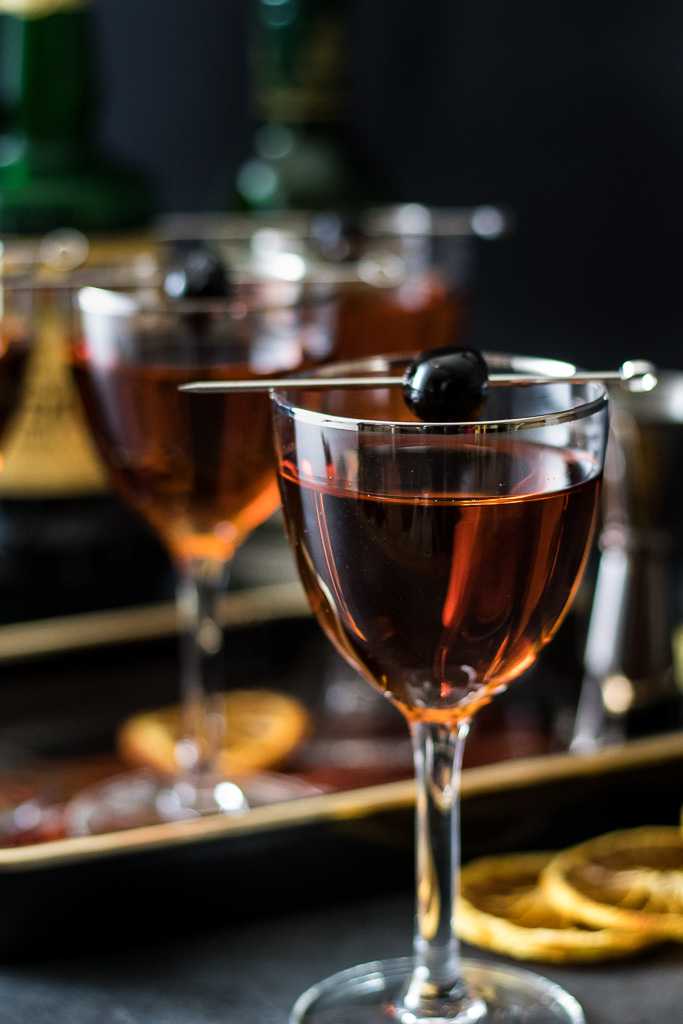
Try a different brand or style of sweet vermouth. Because vermouths are infused with different botanicals, they can vary wildly. Experiment to find the one you love. Try French rouge vermouth if you’re partial to sweet Italian vermouths. Branch out and try a dry vermouth in your Manhattan. Perhaps you might like a bit of Punt e Mes or Lillet Blanc to substitute for the sweet vermouth. As an experiment, omit the sweet vermouth and use a nontraditional flavor or liqueur as the third element in the cocktail.
PLAY WITH THE RATIO
To discover your perfect Manhattan, adjust the ratio—a little more whiskey to a little less vermouth, or a little more vermouth and bitters. You can even combine vermouths to blend the botanicals from two sources. Here are some common ratios to try in a Manhattan:
- 2 whiskey : 1 vermouth (the classic)
- 2.5 whiskey : 0.5 vermouth
- 2 whiskey : 0.75 vermouth
Cocktail Lab
Vermouth and Liqueur Experiment
The best cocktails come from experimentation, and it’s time to put on your cocktail lab coat! For this one, gather a mixing glass, stirrer, and strainer, along with rye, bourbon, sweet vermouth, dry vermouth, amaro, and bitters. You’ll be making four versions of the Manhattan. To make this as scientific as possible, use the same whiskeys and bitters in each one so that you can taste the differences in the expressions.
- Make a split-base Manhattan. Using the instructions for the classic Manhattan recipe given earlier, use 1 ounce rye, 1 ounce bourbon, 1 ounce sweet vermouth, and 3 dashes Angostura bitters. Strain into a serving glass and garnish. In a split[1]base Manhattan, you get pepper and spice from the rye, which balances well with the bourbon’s sweetness. It might become your favorite iteration.
- Make a Perfect Manhattan. In cocktails, perfect refers to a 50-50 split in an element. In this case, it means using half sweet vermouth and half dry. This variation is perfect for bourbon lovers who find the Manhattan too sweet. Using the instructions for the classic Manhattan, use 2 ounces bourbon, ½ ounce sweet vermouth, ½ ounce dry vermouth, and 3 dashes Angostura bitters. Strain into a serving glass and garnish.
- Make a Reverse Manhattan. This version reverses the ratio of whiskey to vermouth. This cocktail’s lower proof and enhanced botanical flavors make it perfect for people who enjoy gin- or wine-based cocktails. Using the instructions for the classic Manhattan, use 2 ounces sweet vermouth, 1 ounce bourbon, and 3 dashes Angostura bitters. Strain into a serving glass and garnish.
- Make a Black Manhattan. This variation substitutes amaro for the sweet vermouth. Amaro is an infused bitter liqueur used as an after-dinner drink to improve digestion. The bittersweet amaro draws out completely different aromas and notes from the whiskey. Using the instructions for the classic Manhattan, use 2 ounces bourbon, 1 ounce amaro, and 2 dashes Angostura bitters. Strain into a serving glass and garnish.
Once you’ve sampled all the variations, compare and contrast them. Note which ones you love and which ones you don’t. More important, figure out why you don’t like some of them. Are they too floral? Too high proof? Are they too sour from the vermouth? This process helps you identify and refine your own aroma, flavor, and finish preferences.
Dos and Don’ts for Making a Manhattan
Do use a bourbon or whiskey you love. The whiskey is the star of the show. It’s fine to use a whiskey that’s not expensive, but choose one you enjoy drinking.
Do experiment with liqueurs and other wine-based products. Substitute a liqueur or port or sherry wine for the vermouth in a Manhattan. Try reducing the amount of whiskey and adding another flavor. Half an ounce of chocolate, nut, or cherry liqueur can change the tone and balance of the cocktail.
Do keep vermouth refrigerated. This keeps it fresh as you use up the bottle.
Do perform the sniff test for bitters. If you’re not sure which bitters will work with the base spirits you’re using, nose the whiskey and vermouth alongside the bitters choices. If they smell good together, chances are they’ll make a great cocktail. But if they clash or compete, move on to another bitters.
Don’t skimp on the garnish. Use fresh orange peel and high-quality cherries. Many people swear by Luxardo or Bada-Bing cherries. Be sure to express the oils from the orange peel over the cocktail before adding it to the glass.
Do chill the glass. Keep the coupe in the freezer or fill it with ice to chill while you make the cocktail. Because the Manhattan is served up (no ice), chilling the glass keeps the cocktail cold longer.
Espresso Manhattan Cocktail
Use a whiskey with strong vanilla and caramel notes to simulate the taste of a fancy, high-proof latte. If you can’t get the specific bitters called for in the recipe, experiment with any coffee and chocolate bitters you have on hand until you find the perfect balance.
1½ ounces midproof bourbon
½ ounce coffee liqueur (I use Patron XO Café)
½ ounce sweet vermouth
½ ounce espresso, cold-brew, or any cold, strong coffee
5 drops Crude Big Bear coffee and cocoa bitters
1 dash Bitter Truth chocolate bitters
Garnish: coffee beans and orange peel
Combine ingredients in a mixing glass. Fill with ice and stir until chilled and well combined, about 30 seconds. Strain into a chilled coupe glass. Garnish with a few whole coffee beans and an orange peel.
Rosaline’s Rebuff Cocktail
I created this cocktail for a whiskey group called the BARDS (Bourbon and Rye Drinkers Society). It’s based on a quote from Shakespeare’s Romeo and Juliet: “What’s in a name? That which we call a rose by any other name would smell as sweet.” Rosaline is the woman Romeo was lusting after before the story starts. If he hadn’t been rebuffed by Rosaline, his love story with Juliet never would have happened. I wanted to emphasize that love includes bitterness, so this cocktail had to be less about sweetness and more about balance (of love and fate). The Aperol, Chambord, and infused vermouth all give the drink a beautiful rose hue.
1 ounce Rittenhouse rye or high-rye bourbon
½ ounce Chambord black raspberry liqueur
3–5 drops rose water
Garnish: fresh raspberry or edible rose petal
Combine ingredients in a mixing glass, add ice, and stir for 30 seconds or until chilled. Strain into a chilled coupe glass and garnish.
Rose-Infused Dry Vermouth
1 cup dry vermouth
1½ tablespoons food-grade, organic dried rose petals
Combine vermouth and rose petals. Infuse for 1–2 days, depending on how much rose flavor you want in the vermouth
Black Licorice Manhattan Cocktail
If you love licorice or star anise, this cocktail is for you. It’s wildly fragrant with licorice and spinning with citrus notes and chocolate earthiness. Every time I make this cocktail, I wish I’d made two. It’s not a traditional Manhattan, but it’s a balance of the flavors I love in my favorite bourbon expressions: citrus, chocolate, and licorice. 1½ ounces low- to midproof bourbon
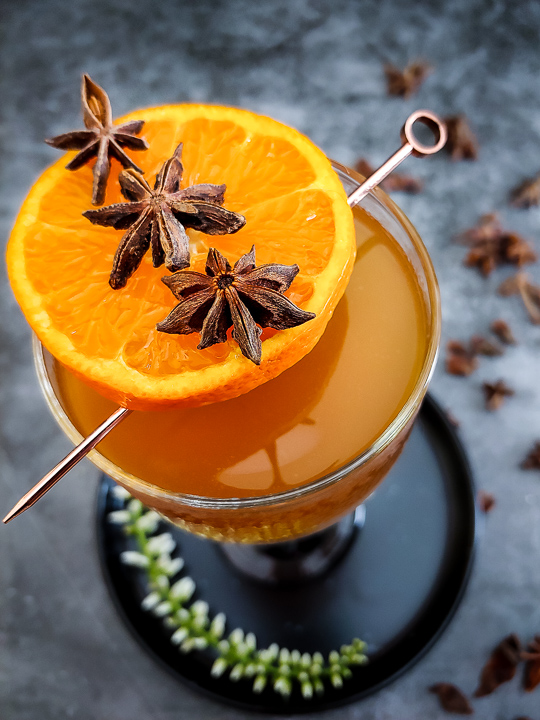
½ ounce oleo saccharum
¾ ounce Ballotin chocolate whiskey (do not use a cream-based chocolate liqueur)
¼ ounce Copper & Kings absinthe
10 drops Woodford Reserve orange bitters
2 dashes Bitter Truth chocolate bitters
Garnish: orange wheel with star anise or chocolate shavings
Combine ingredients in a mixing glass and fill with ice. Stir for 30 seconds. Strain into a chilled coupe glass and garnish.
Midnight Hour Cocktail
It’s time to get dark with my version of a Black Manhattan. It uses amaro, a bitter Italian digestif, paired with some autumn bitters to make a lovely dark drink to close out the fall.
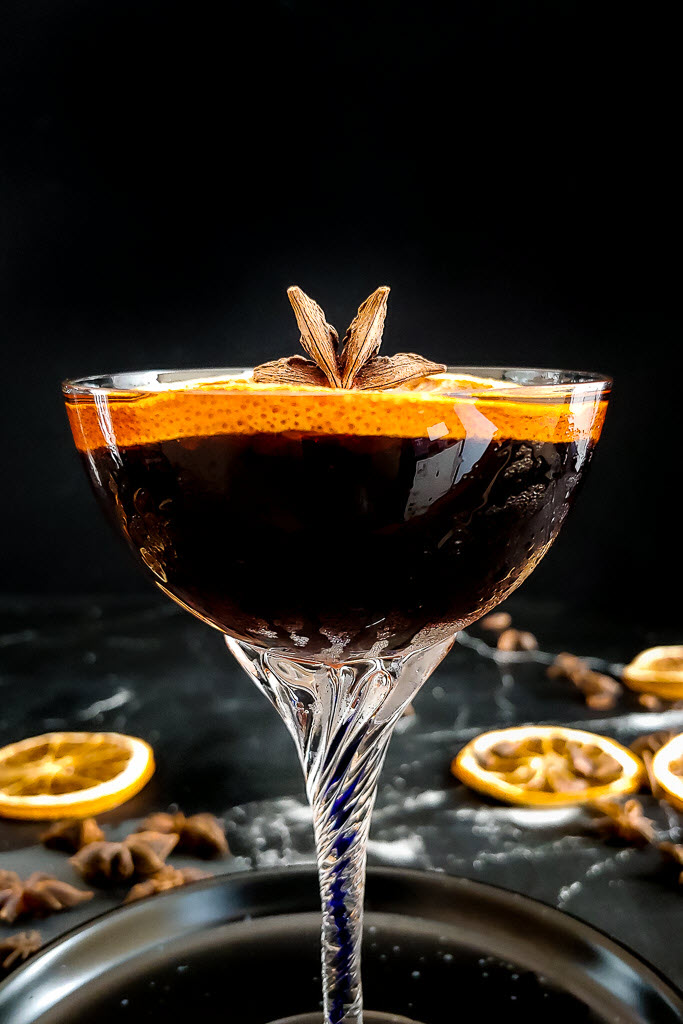
2 ounces bourbon or rye whiskey (95–105 proof)
¼ ounce Carpano Antica sweet vermouth
¾ ounce Amaro Averna
8 drops Woodford Reserve sorghum and sassafras bitters
4 drops Bittermens Elekamule Tiki bitters
Garnish: lemon peel and cocktail cherry
Combine ingredients in a mixing glass and fill with ice. Stir until well chilled, about 30 seconds. Strain into a chilled coupe or martini glass and garnish.
Drink Like a Girl Cocktail
My first sip of this cocktail was a revelation. Caramel and chocolate notes soar through the palate, and underneath is a solid foundation of great bourbon. This is a sweet after-dinner drink that’s easy to put together and even easier to sip. It calls for a caramel liqueur, but make sure you use a noncreamy one (no Bailey’s or cream liqueurs).
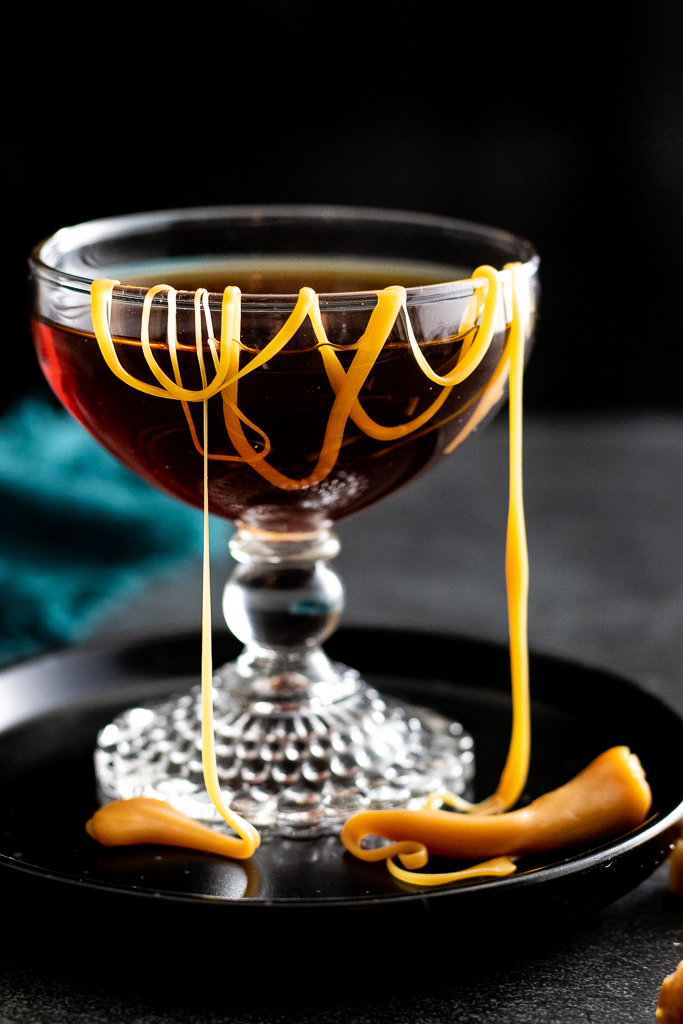
1½ ounces midproof bourbon (I use 100-proof)
½ ounce Stroopwafel caramel liqueur or other noncreamy caramel liqueur
½ ounce chocolate whiskey or crème de cacao
2 dashes chocolate bitters
2 dashes aromatic bitters
Pinch of salt
Garnish: sea-salt caramel
Chill the glass. Pull a sea-salt caramel into a long string and drape it around the rim of the glass. Set aside. Combine ingredients in a mixing glass, add ice, and stir for about 30 seconds or until well chilled. Strain into the prepared glass.
And as always, we highly recommend that you drink responsibly at all bourbon tastings.
“The Manhattan – A Cocktail Classic for the Bourbon Drinker” is one of many tales from Bourbon is My Comfort Food: The Bourbon Women Guide to Fantastic Cocktails at Home – by author Heather Wibbels. This hardcover book features more than 250 pages with stories and beautiful photography to help you on your bourbon cocktail journey. You can pick up your own copy of Bourbon is My Comfort Food here.
Please help to support Distillery Trail. Sign up for our Newsletter, like us on Facebook and follow us on Instagram and Twitter.
As an Amazon Associate, we may earn commissions from qualifying purchases.

